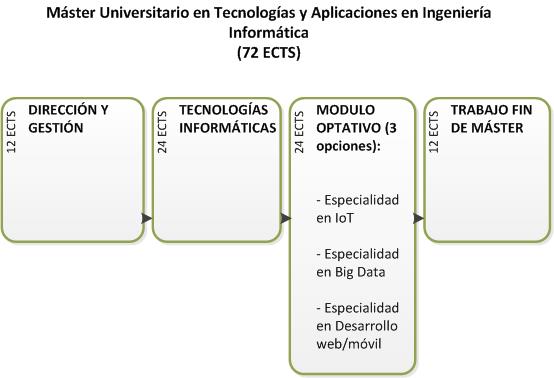Structure and distribution of credits
{{pre.error[0].message}}
{{pre.error[0].message}}
| Course | Basic | Mandatory | Optatives | Curricular internships | End of Studies Dissertation | Total |
|---|---|---|---|---|---|---|
| {{curso}}º | {{c.credects}} | {{c.credects}} | {{c.credects}} | {{c.credects}} | {{c.credects}} | {{creditos | map: 'credects' | toArray | sum}} |
| Total | {{ct.credects}} | {{ct.credects}} | {{ct.credects}} | {{ct.credects}} | {{ct.credects}} | {{cre.creditos_totales | map: 'credects' | toArray | sum}} |
The curriculum of the Master's in Computer Enginering Technology and Applications consists of six modules: three of them have a structure similar to the one proposed in the agreement of the Council of Universities on Master’s degrees leading to the profession of Computer Engineer, published in the Spanish Official Gazette on August 4, 2009, and the other three proposed as elective specialisations. These modules are: Direction and Management (Compulsory, 12 ECTS), Computer Technologies (Compulsory, 24 ECTS), Internet of Things (Elective, 24 ECTS), Big Data (Elective, 24 ECTS), Web/Mobile Development (Elective, 24 ECTS) and Master’s Thesis (Compulsory, 12 ECTS). To achieve the degree, one of the three elective modules has to be compulsorily taken.
The student will complete these modules in 3 semesters. In the first semester, students will take the Direction and Management and the Computer Technologies Modules (except for one of the subjects of this last module, which will be taken in the second semester). In the second semester, students will take the chosen Elective Module (from among the three proposed options) and a subject of the Computer Technologies Module. The following year will last a single semester in which students will carry out the Master’s Thesis.
This organization aims to divide training into two stages. In the first stage, with a duration of two semesters, students will acquire direction and management skills of computer projects together with a series of specific computer technology competencies associated with different professional profiles of computer engineering. Development in this first stage is based on different subjects taught face-to-face. In the second stage, developed in the last semester, students will carry out the Master’s Thesis which may be the result of the work done in a company of the sector, although always under the codirection of the faculty assigned to the master's degree.
